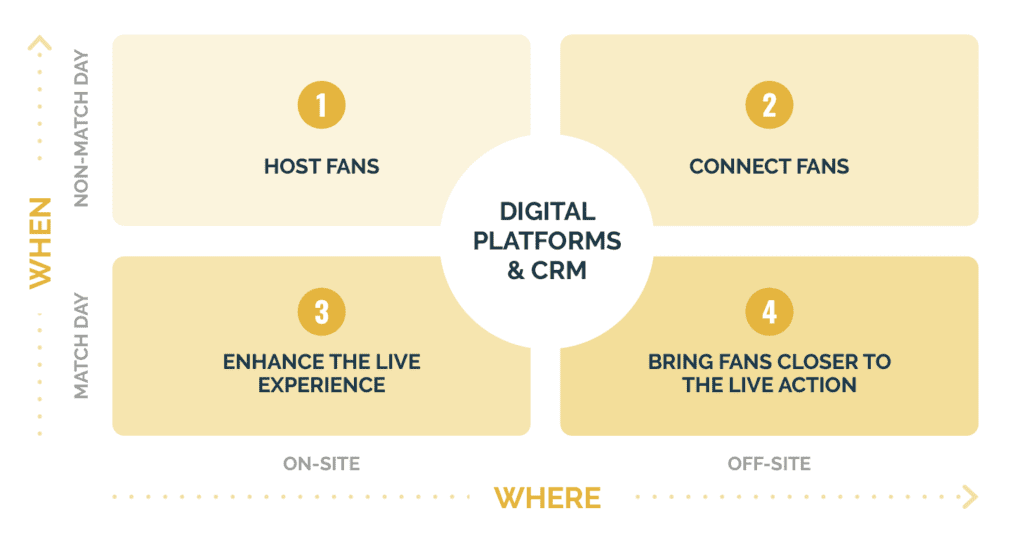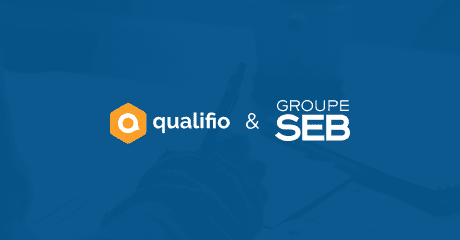Fan engagement at the heart of the sports industry
Fan engagement: what is it? Why does it matter so much in the sports industry? And how are content providers making the most of the industry’s digital renaissance to bring fans closer to the game and the sports brands they love?
In this article we’re going to be taking a closer look at the impact that fan engagement is having on the industry, how clubs are embracing it to engage fans and reward loyal fans, and how it’s changing the way fans interact with their favourite sports leagues and clubs.

To understand how fan engagement can be used to improve accessibility and connectivity to sports, while adding a good dose of fun and emotion, I spoke to one of Qualifio’s partners, Marcel Heße, CEO and co-founder of mycrocast, an open platform that combines audio and fan engagement.
Fans at the heart of an industry
One small word lies at the heart of all sports clubs and organisations, and defines the very heart and soul of the industry: fans.
As we recently explored in our ebook “The future is fan-tastic”, the sports industry is fundamentally an industry based on engagement and community. The millions of people who are involved in sports, whether on a professional level or as a fan, and whether on a local amateur level or at a higher national level, are all passionate about their club, their league or their national team.

And that’s without counting on the billions of fans around the world who watch, enjoy, take part in, comment on, argue about, and simply love sport. Have you ever considered the number of viewers worldwide who tune in to watch large-scale international events like the Olympics, the football World Cup or the Super Bowl? They are mind-boggling! In recent years, with games and matches being played behind closed doors and competitions being halted during the pandemic, the importance of competitive sport for so many fans became more evident than ever.
So needless to say there is a huge amount at stake across the industry, not only from a financial point of view but also from a societal and cultural perspective.
Let’s take a closer look at how fan engagement can be used to improve the fan’s brand experience, encourage brand loyalty and ultimately increase revenues.
What is fan engagement?
The Johan Cruyff institute define fan engagement as:
all the activities either online or offline that are conducted by fans to help the team and other fans, either in a direct or an indirect way.”
Further to that, fan engagement can be transactional and direct (with an exchange of time, money or effort) or non-transactional and indirect (that adds value without being directly linked to consumption).
The emotional connection that fans have with their favorite team is seen as the main vector for fan engagement, as without their devotion, sporting events and organisations would simply not exist.
The concept was born in North America in the 1990s and has gradually made its way across the Atlantic, truly taking off in Europe since the early 2000s with the rise of new technologies and social media. Fans and clubs are now connected 24/7 with a multitude of touch points and communication channels available to them, regardless of where they are in the world.
The GSIC (Global Sports Innovation Center, powered by Microsoft) have identified fan engagement as one of the key areas that actors in the sports industry need to focus on in the next few years.

The challenge of capturing and harnessing fan engagement is a particularly tough challenge for sports clubs, especially when it comes to the younger generations. They typically have shorter attention spans and have much higher expectations of the personalised and unique experiences they’re looking for from sporting bodies. Both in terms of match day experiences in the stadium, but also in terms of online experiences on non match days and during the off season.
Fan engagement in the cookieless era
It’s no longer front-page news but it’s still a crucial topic in the digital ecosphere: third-party cookies have been run out, and first- and zero-party data collection strategies are the new MVP. These changes in the way that brands can get to know and can reach their users will have a significant impact across all industries, with sports organisations being no exception.
In order to survive and thrive in a digital world without third-party cookies: sports brands will need to collect data from their fans in a well-structured and efficient way.
Curious to find out more about how football clubs are including first- and zero-party data collection in their marketing strategy to get closer to their fans? Make sure you check out our success stories with French Ligue 1 champion, LOSC, and Spanish club, Valencia CF!
Want to discover other inspiring campaigns created by our users?
Take a look at our catalogue of all-time favourite campaigns!
How can sports brands harness fan engagement?
In order to deliver better fan experiences, clubs need to focus on the feedback they’re getting from their fanbase, in order to get a better understanding of what it is their fans are expecting.
Here are a few fan engagement strategies:
⛹️ Headline your players in your content and make the most of the incredible sporting talent at your fingertips. Set up down-to-earth interviews with your players asking them personal questions and getting them to do fun things, show rarely-seen behind-the-scene footage on match day, get your fans to be journalists for a day, or run competitions for fans to meet with their favorite players – these are all ways of creating memories and experiences that all your fans will enjoy and relate to.
🤳 Don’t underestimate the power of UGC (user generated content) to get your fans involved and interacting with your social media platforms and content. Why not organise a video contest with the best chants heard or the best tifosi seen in your stadium, or a photo contest for fans attending games and rewarding the best selfie!

🏟️ Follow the example of Premier League club Manchester City who have equipped their stadium with free high-speed internet, to encourage fans to interact with the club’s social media platforms during games.
📲 Focus on your social media platforms by implementing a comprehensive content strategy and interacting with your fans, giving them a feeling of belonging to their club/team and of community. A great way to do this is with interactive marketing campaigns! Check out Qualifio’s +50 formats, including polls, surveys, quizzes, games and much more!
🗣️ Why not replicate what Italian club AS Roma did with their fan engagement strategy by asking your fans for feedback and actually using it! This is exactly what they did when creating their new website: they asked their fans what they wanted to see and then provided them with exactly that. A great way of getting fans involved in the day-to-day life of the club and of showing them that their opinions count and that they’re being heard.
Bringing innovative audio solutions and fan engagement together

To get a better understanding of fan engagement and how it can be used to bring sports fans and sports organisations closer together, we sat down with Marcel Heße from mycrocast to chat about how their innovative approach to audio content is entertaining and engaging fans of sports clubs across Europe.
Q&A with Marcel Heße from mycrocast
Qualifio: Could you briefly present mycrocast’s solution and what you offer to the sports industry?
mycrocast: mycrocast is an open platform that combines audio with fan engagement. Our motto is “Breaking barriers with audio” and we create connectivity between clubs, associations, fans and amateurs in different ways. For example our partners provide emotional audio commentaries of the matches. Fans then listen to someone who’s speaking from the heart. The partners can also include visually impaired fans in and around sporting venues thanks to our software.
Q: What are the main needs of the sports industry that your solution addresses?
m: In recent years, some fans have felt disconnected and no longer fully identify with professional sports. We want to bring this closeness back and also create opportunities to attract new fans emotionally. Audio is perfect for this, because it is so great at conveying emotions. Offering a Spanish commentator for a club with an Argentine player, for example, can thus lead to the creation of a fan base in Argentina, simply due to the fact that you reach the fans on an emotional level and get them excited about your own club, even if they live thousands of miles away.
Q: What are the key challenges that the industry is facing in terms of fan engagement?
m: To create closeness, you have to convey authenticity. Fans want to look behind the scenes and perceive their stars as humans. It’s about getting back to basics and understanding the fan. That’s why the participation of all fans is important to us. Regardless of whether they have a handicap or a language barrier, we break down these barriers.
Q: What are the key learnings you’ve noticed in the industry in the wake of the pandemic?
m: The industry has understood that it’s not just about the game and the competition itself. You have to create content all around. eSports has clearly shown the importance that continuous content creation can have.
Q: Could you share any great examples of fan engagement from sports teams who have used your platform?
m: Hamburger SV is a great example of fan engagement via audio. They offer live commentary for every game. The fan doesn’t tend to enjoy the neutral coverage provided by TV stations as it is neutral, so they watch the game on TV or stream but are bothered by the commentator. So the fans go to the Hamburger SV media and listen to the HSV fan radio. They now have the option of switching off the TV sound and synchronising the fan radio sound with the TV picture instead. Now they are listening to someone who speaks from their heart and does not quite adhere to this neutrality. Making it much for entertaining and engaging! Hamburger SV thus reaches up to 80,000 users per game and profitably integrates sponsors into the broadcast.
Q: What are the next technological developments that you see having a big impact on the sports industry?
M: For us, at the moment the use of audio in sports has only scratched the surface of what’s possible. With live coverage through our software, a first step has been taken. We want to become the Instagram for audio in sports. Clubs, federations, athletes, fans and amateurs will be able to create and consume different audio formats together.
When all is said and done
Like many industries, the sports industry is going through monumental changes and will continue to do so over the next few years, as technological advances move forward and as sports fans become increasingly involved with their favorite clubs and teams.
Sports teams, clubs, organisations, leagues, venues and companies, will all have a lot of challenges ahead and one of the main ones will be understanding and getting to know their fans, in order to harness their engagement, improve their brand experience and reward their loyalty.
The solutions are wide and varying, but they all revolve around a central element: having a meaningful and long-lasting relationship with fans, based on trust and a sense of community. So whilst creativity and imagination are key, first- and zero-party data collection strategies and interactive marketing are a great place to start!

Over 50 interactive formats to choose from for your marketing campaigns!









